-
Car Reviews
- Car News
-
Car Comparisons
Latest comparisons
- Chasing Deals
Toyota’s Yaris Cross Hybrid is the fuel economy hero of the light SUV segment, with lengthy waiting list to match, but can it justify its near $40,000 on road price?
Toyota bosses the hybrid vehicle landscape, and its tiny Yaris Cross is the smallest SUV in its portfolio to feature the petrol miser technology.
You can see the mass appeal. This city SUV works for retirees, empty-nesters, childless couples or as an urban runabout second car. It has the funky looks, and certainly the budget running costs.
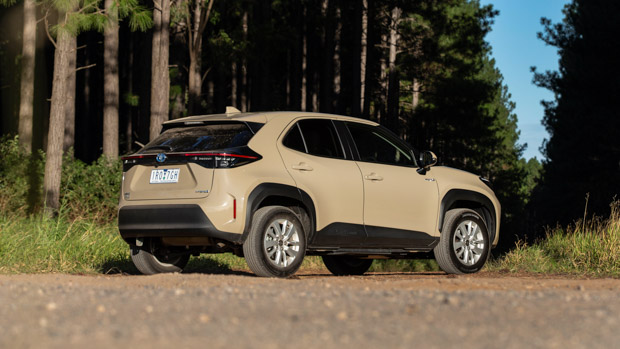
First car buyers would love a crack too, but costing from about $33,000 on the road, these jacked up hybrid Crosses are far from cheap. Ask for a bit more kit – as with our mid-spec AWD GXL tester – and you’re nudging $40,000 on the road. That’s entry-level RAV4 money.
Regardless, Toyota can’t build ’em quick enough. Waiting lists remain painfully long, and we’ve spotted dealer ‘used’ (er, with 11km on the clock) Yaris Cross Hybrids being flipped for $10,000 over retail prices. Strange times indeed.
You’d expect it to be God’s gift to motoring then, right? While there’s plenty to impress – superb hybrid system, huge safety kit and a properly fun drive – its price simply doesn’t square with the car presented before you.
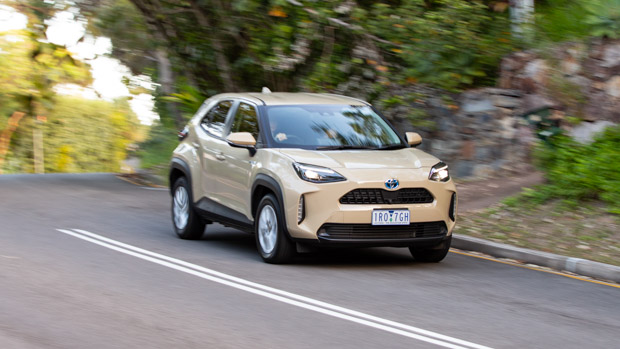
Cabin materials and finish, lacklustre performance and practicality remain wedged in a place we’ll call Budget Corner. An SUV? Good luck finding the Sport or Utility in this little vehicle.
It tows just 400kg braked or unbraked (non-hybrids manage 1250kg braked) and while our tester has all-wheel-drive; its 170mm ground clearance, 205/65R16 road tyres and repair kit in lieu of a spare means you shouldn’t rush to find your nearest dirt road.
But you could say the same for every offering – bar the Suzuki Jimny – in the ever-expanding Light SUV segment. Titchy soft-road rivals with $30,000+ RRPs include the Ford Puma, Renault Captur and Volkswagen T-Cross – and none can be had with all-wheel-drive.
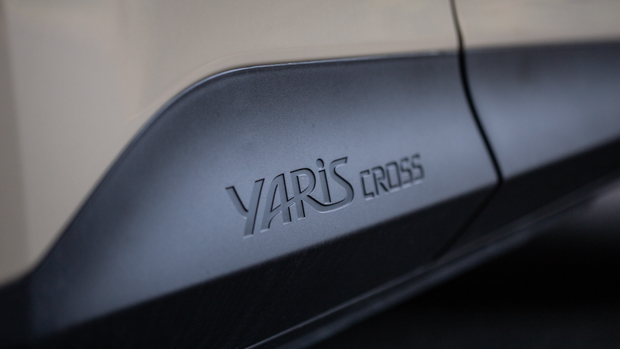
If it’s all too rich for your blood, entry-level variants of the Hyundai Venue, Kia Stonic, Mazda CX-3 and Suzuki Ignis occupy the Light SUV space between $19,500-$23,500; and have pared-back cabins to suit.
All of the above are petrol engine only. The Yaris Cross is the only one, so far, to bring hybridisation to the segment. But does that make it the pick of the bunch?
You can buy a non-Hybrid Yaris Cross, but you shouldn’t. It uses an 88kW/145Nm non-turbo 1.5-litre petrol three-cylinder engine which feels gruff and old once you leave the city’s slow-speed confines.
It’s about $2000 less to go non-hybrid, but higher fuel bills (especially in town), less torque pull, no EV-only mode and worse resale make it the runt of the litter. Always stretch to the hybrid if you can, even if it means a longer waiting list.
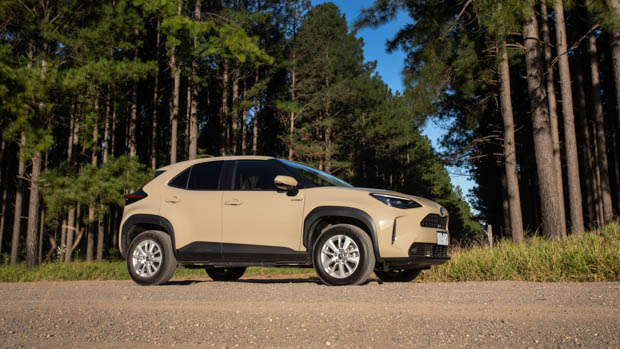
The hybrid start point is the GX FWD, from about $33,000 on the road. It includes a CVT auto gearbox, LEDs for taillights, daytime running lights and rear fogs, auto fold electric mirrors and 16-inch alloys.
Climb in the Yaris Cross and while the overall cabin feel is one of simplicity and basicness, there’s a reasonable amount of inclusions.
All have a digital instrument cluster, 4.2-inch multi-info display, leather-accent steering wheel, 7.0-inch infotainment, DAB+ radio, Apple CarPlay/Android Auto (wired), climate control, electronic park brake, smart entry and start and Toyota’s Connected Services for three years.
The GXL with FWD (about $36,000 drive away) is the pick to boost the car’s safety credentials (see safety section below). It also adds LED headlights and turn signals, rear privacy glass and sat nav.
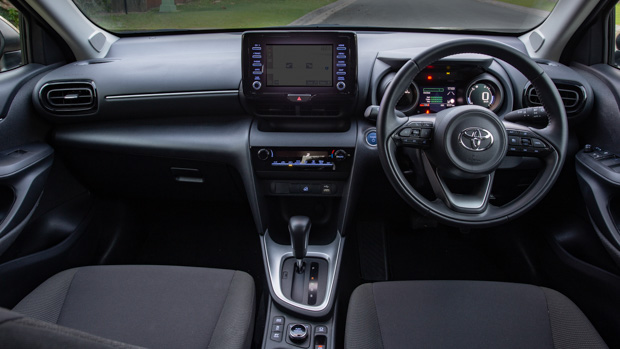
For about $39,000 drive-away you’re in the fancy Urban grade. It uses 18-inch alloys, tweed-like fabric and synthetic leather-accented heated seats (power for driver), a head-up display, power tailgate with kick sensor and an extra USB port in the dash.
A Yaris Cross GR Sport has just landed, priced from around $39,000 on the road. It’s only available as a FWD and a Hybrid, has no power or torque gains but gains a re-tuned, 10mm-lowered suspension setup.
It also gains a black grille, rear diffuser, unique 18-inch alloys with grippier rubber, red calipers, faux leather and suede seats, aluminium pedals and ornamental gun metal trim bits.
Now, let’s address the all-wheel-drive aspect. All bar the GR Sport can be optioned in AWD, but I can’t see the value in it here, and certainly not for the extra $3000 Toyota asks.
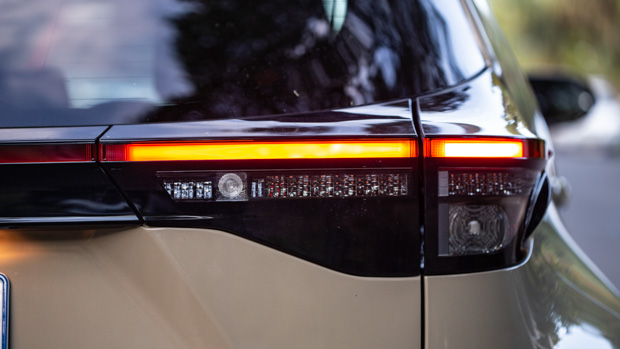
Why would you pick it? It gains a third electric motor generator to drive the rear wheels if it decides you need better traction when surfaces get loose or slippery. There’s even a Snow and Trail mode to better arm the system.
Fair enough, but the car’s already incredibly smart and effective stability control systems will save you in most driving situations, as long as you’re not playing at being Sebastien Loeb in your Yaris Cross. The AWD wouldn’t save you here either, by the way.
A FWD Yaris Cross Hybrid is some 70kg lighter than the all-paw version, making it more economical and better at braking.
The ‘but’ is the AWD models having independent rear suspension rather than the FWD’s less complex torsion beam setup.
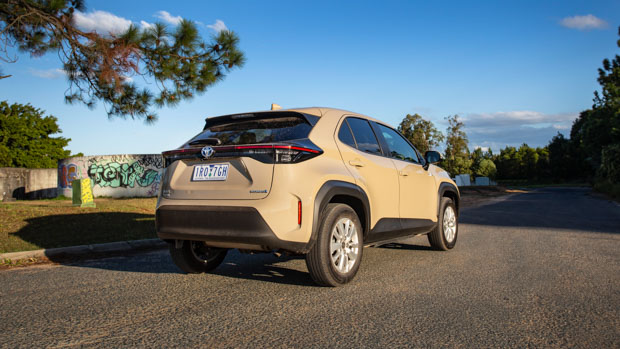
This would be a deal-breaker in a hot hatch or sports car, but a light SUV? Really, the FWD handles well enough and does a decent job of soaking up bumps even without a multilink rear end.
One of the best things about shopping in the light SUV segment is the range of interesting colours. These are fun little city things, and suit a vibrant hue rather than the usual monochrome misery.
Black’s the only free colour, so you’ll want to splash out an extra $550 for something like our tester’s Latte. There’s Tuscan Gold, Lunar and Mineral Blues, Atomic Rush red, plus the safer territory of silver or white.
It’s a little gem in town, especially running purely using battery power and its three electric motors (two at the front, one at the back) in slow-moving traffic.
Toyota’s ‘series-parallel’ hybrids aren’t to be confused with anything that needs plugged in. The hybrid’s battery charges while you decelerate or brake, and does so without you noticing.
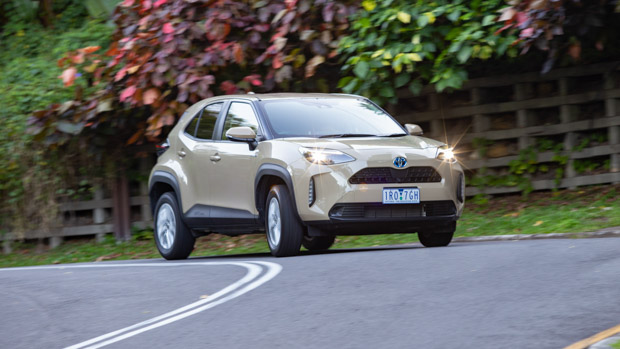
The main propulsion source is a 67kW/120Nm 1.5-litre three-cylinder petrol engine. The hybrid system’s electric motors bump the combined power to a reasonable 85kW, but the big gain comes in the torque department.
Toyota doesn’t reveal the amalgamated torque figure, but petrol and battery combine to offer zippy pull from slow speed.
The car starts in electric-only mode. It’s silent, so until you get used to this, you don’t realise the thing’s actually running. If you’re easy on the throttle you pull away using just the battery too, and it’s a lovely, relaxing electric experience.

It’ll only let you reach about 30km/h before calling for petrol backup, and the switch isn’t as seamless as in other Toyota hybrids.
I put this down to the nature of a three-cylinder engine, which unlike larger four-cylinders, has more of an off-beat noisy nature. In other words, there’s no “seamless shift” between electric and petrol power, no matter what Toyota’s advertising material says.
Sitting in traffic, as long as there’s juice in the battery from your braking (it doesn’t take much to recharge), the drive is at its most rewarding. You zip along with no noise and burning zero fossil fuels, helping that extraordinarily good urban fuel economy.
You can see what the hybrid system’s up to through the touchscreen: is it running on electric, petrol or a combination of the two, or is energy being returned to the battery? As long as there’s charge and you’re going slowly enough, an EV button means you take control and insist this part of the journey will be electric only.
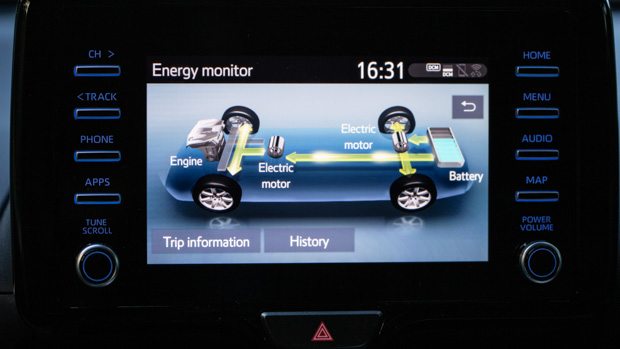
The CVT and three-cylinder engine are a decent pairing for slow speed work. While quite responsive in town, when up to speed if you ask for more oomph things get gruffer and shoutier. If there’s an uphill involved it struggles for puff and it’s all a bit noisy.
It cruises peacefully on the highway, and displays a playful side when you throw it into some corners. It’s a well-balanced thing, and weighing under 1300kg it changes direction with decent agility.
More steering weight would be nice – as would a manual gearbox to have a greater say in the rev range – but otherwise there’s plenty here to deliver driving smiles.
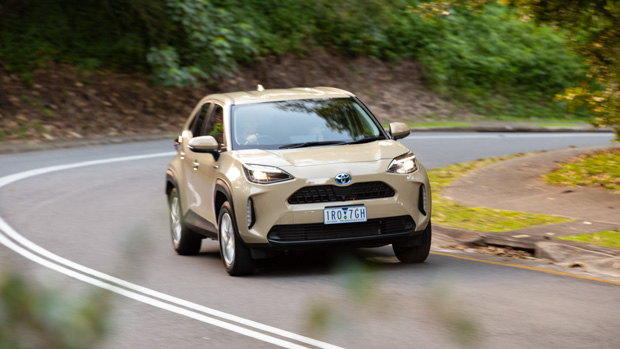
Toyota’s resisted putting too-large a wheel and too low profile a tyre on this grade. Pricier Yaris Crosses use an 18-inch setup, but the reasonably fat tyres over 16-inch alloys do a fine job of mopping up bumps and holes in the GXL.
At speed, on really sketchy surfaces, it gets crashy, but if you stick to the city streets the general ride quality is impressive for such a small vehicle.
Typical of these littlest of cars, open the bonnet, boot and doors and they feel flimsy. Same when you climb inside.
The doors tops and parts of the centre console are of hard plastic, while door trim is a combination of plastic and thin-feeling fabric. Criminally, no central armrest either.
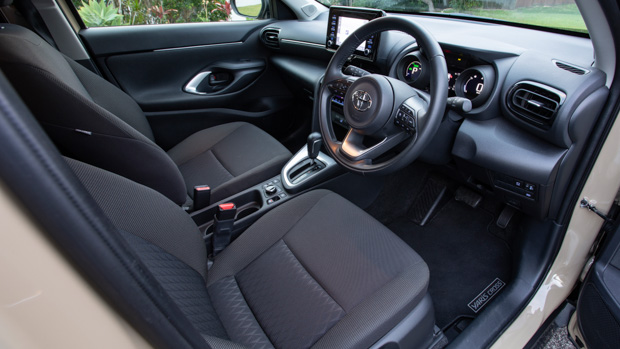
Positively, you get plusher, soft-touch plastic for the dash top, while the pleasingly small steering wheel getting the leather accent treatment makes a big difference – no cheapie plastic tiller to be found here.
While it feels well built and smartly laid out, it’s not an interior to surprise or delight.
The 7.0-inch screen looks small and basic by modern standards, and is tacked-on rather than integrated. Just the single USB port and no goodies like wireless charging or wireless CarPlay/Android Auto.
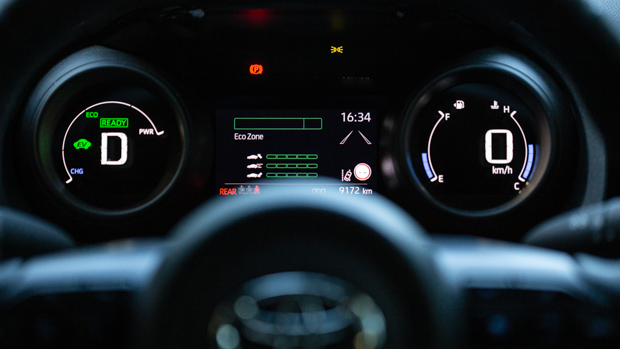
But a concession to modernity is found right in your eyeline. Instead of a conventional speedo and tacho there’s a brace of digital gauges, including a large-sized digital speedo.
Plenty of info is found in the digital info screen in between, including your in-built navigation. Greater ride height and seating position is a key selling point for going Cross, and you do feel higher up than you’d first expect for such a small car.
Seats are fairly comfortable and supportive, although the fabric used isn’t the flashest.
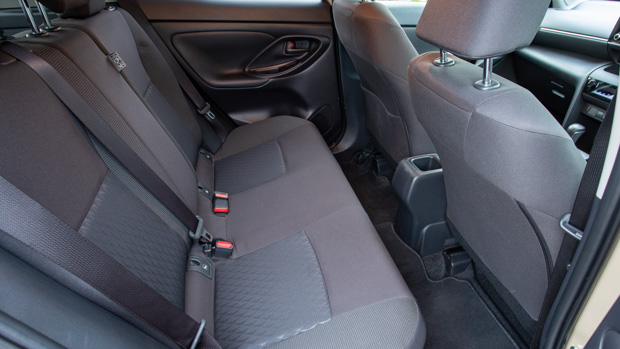
I can’t imagine many Yaris Cross buyers will regularly have rear passengers, but if so, they enjoy good headroom but will find legroom stingy. Don’t expect rear air vents, but the central seat folds down to provide a couple of bottle holders.
The rear seats split-fold 40/20/40, offering more luggage space that provided by the 314L boot. Another reason to go FWD? It has a false floor, which can be lowered to provide a more useful 390L. There’s also a space-saver spare under here, unlike our AWD’s repair kit.
It all gets very modern with three years complimentary access to Toyota Connected Services.
Your car pairs to a myToyota Connect phone app, meaning you can check your fuel level, odometer, travel details, last known location and parking spot. Great for seeing where your kids have really taken your car.
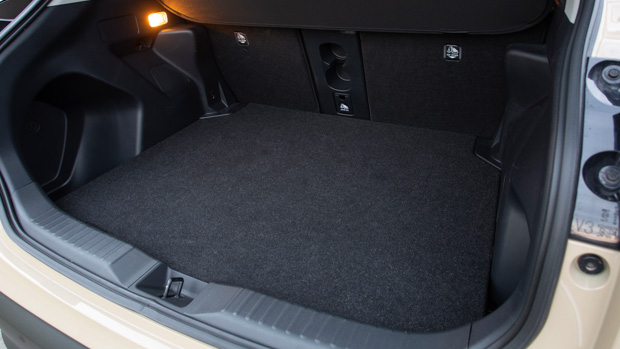
Safety-wise there’s an automatic collision notification if an airbag goes off or a severe collision’s detected.
Should this happen Toyota Emergency Assistance contacts you through the vehicle. If there’s no response, they’ll send emergency services to your location. That’s excellent.
There’s Stolen Vehicle Tracking if your Yaris Cross gets pinched (inconspicuous getaway car?), and there’s an SOS emergency call button should you have need to rapidly summon emergency services via Toyota’s 24/7 call centre.
It was awarded a maximum 5 stars with ANCAP on its 2021 test. It scored 86 percent for adult occupant safety, 86 percent for child occupant safety, 78 percent for vulnerable road user and 82 percent for safety assist.
The 86 per cent adult occupant safety was due to ‘marginal’ results in the 50km/h frontal offset test. Its result means it trails its rival VW T-Cross (97 percent); Renault Captur (96 percent); Ford Puma (94 percent); Nissan Juke (94 percent) and Hyundai Venue (91 percent).
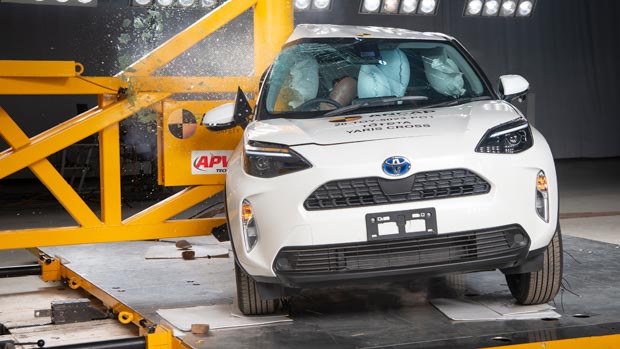
The Toyota Safety Sense suite, plus extra safety goodies, are included range-wide and includes:
Our test GXL adds the following:
In the real world, the blind spot monitor and rear cross traffic alert are the driver aids that are most welcome, helping the case to drop a few more grand on this GXL grade.
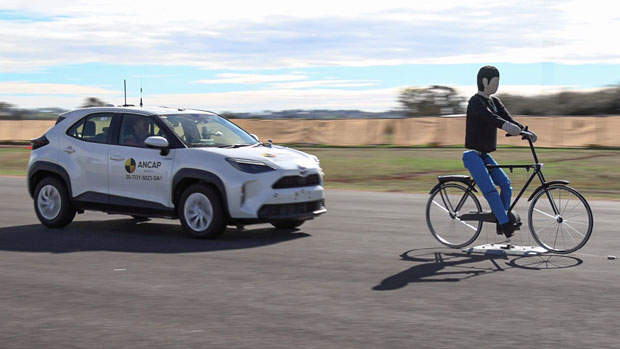
Warnings when reversing out of unsighted parking spaces makes life easier and safer, and are well backed up by the wider-view monitor through the central screen.
Only on one occasion, when parallel parking and a car came past, did the rear alert kick in having mis-read the situation. Better safe than sorry, perhaps.
The radar cruise control performed well, but the lane keep could be aggressive at times, pulling the car sideways as it insisted we should be in the middle of the road at all times.
At least once the chunky purchase price is taken care of, your ongoing bills are minimal. Toyota’s hybrids – no matter the model – are in high demand because they work.
Simple as that. They claim very low fuel use, then back it up in the wild. For urban use, especially, the Yaris Cross can drink half the petrol of some similar-sized non-hybrid rivals as it can run purely on battery power.
This AWD Yaris Cross Hybrid has a quoted figure of 4.0L/100km overall, and 4.4L/100km in town. Our test, over more than 500km, split the difference and returned a superb 4.2L/100km, often with four occupants on-board.
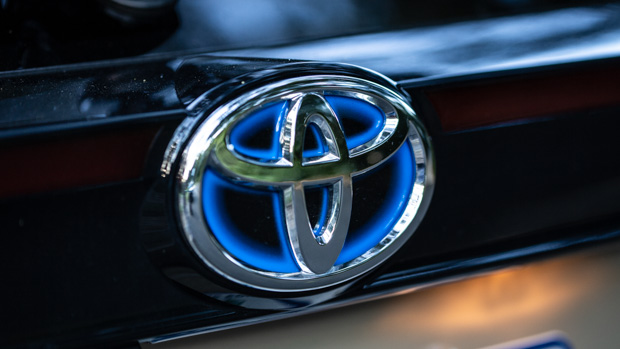
Chasing Cars previously ran a FWD Yaris Cross Hybrid as a long termer and saw an average consumption 3.8L/100km from a mix of driving conditions.
No fancy fuel required either: the Yaris Cross Hybrid slurps cheaper 91RON. Services are annual or every 15,000km and cost $250 a pop – $1250 across the first five years is exceptional value in the current climate.
Warranty is five years/unlimited-kilometre – average, and nothing more. Kia, Mitsubishi and MG offer longer warranties.
The Yaris Cross’s engine and driveline are covered for seven years, while the hybrid battery’s good for ten years if you keep having services done and inspections performed at a dealership during that period.
Fun in town, rides the bumps well and returns superb fuel economy in all conditions. The Yaris Cross Hybrid’s lovely electric-only drive in traffic and hassle-free hybrid nature separate this Toyota from its light SUV rivals.
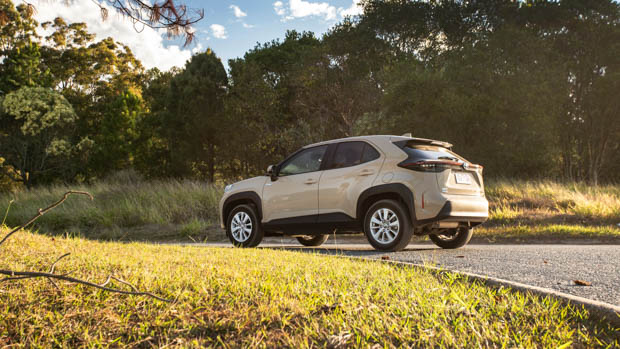
Against these wins, the high purchase price doesn’t match the budget-feeling cabin. While safety kit is comprehensive, the interior and equipment are plain and lacking in some expected mod cons.
I’d save money and choose the FWD entry-level GX Hybrid for around $33,500 drive-away – a price better reflecting the interior experience. Then I reckon you’re in a cracking little hybrid that costs buttons to run and maintain.
Key specs (as tested)
About Chasing cars
Chasing Cars reviews are 100% independent.
Because we are powered by Budget Direct Insurance, we don’t receive advertising or sales revenue from car manufacturers.
We’re truly independent – giving you Australia’s best car reviews.
The estimate provided does not take into account your personal circumstances but is intended to give a general indication of the cost of insurance, in order to obtain a complete quote, please visit www.budgetdirect.com.au. Estimate includes 15%^ online discount.
^Conditions Apply
Budget Direct Insurance arranged by Auto & General Services Pty Ltd ACN 003 617 909(AGS) AFSL 241 411, for and on behalf of the insurer, Auto & General Insurance Company Limited(ABN 42 111 586 353, AFSL 285 571).Because we don’t know your financial needs, we can’t advise you if this insurance will suit you. You should consider your needs and the Product Disclosure Statement before making a decision to buy insurance. Terms and conditions apply.
Indicative quote based on assumptions including postcode , 40 year old male with no offences, licence suspensions or claims in the last 5 years, a NCD Rating 1 and no younger drivers listed. White car, driven up to 10,000kms a year, unfinanced, with no modifications, factory options and/or non-standard accessories, private use only and garaged at night.
^Online Discounts Terms & Conditions
1. Discounts apply to the premium paid for a new Budget Direct Gold Comprehensive Car Insurance, Third Party Property Only or Third Party Property, Fire & Theft Insurance policy initiated online on or after 29 March 2017. Discounts do not apply to optional Roadside Assistance.
2. Discounts do not apply to any renewal offer of insurance.
3. Discounts only apply to the insurance portion of the premium. Discounts are applied before government charges, taxes, levies and fees, including instalment processing fees (as applicable). The full extent of discounts may therefore be impacted.
4. We reserve the right to change the offer without notice.